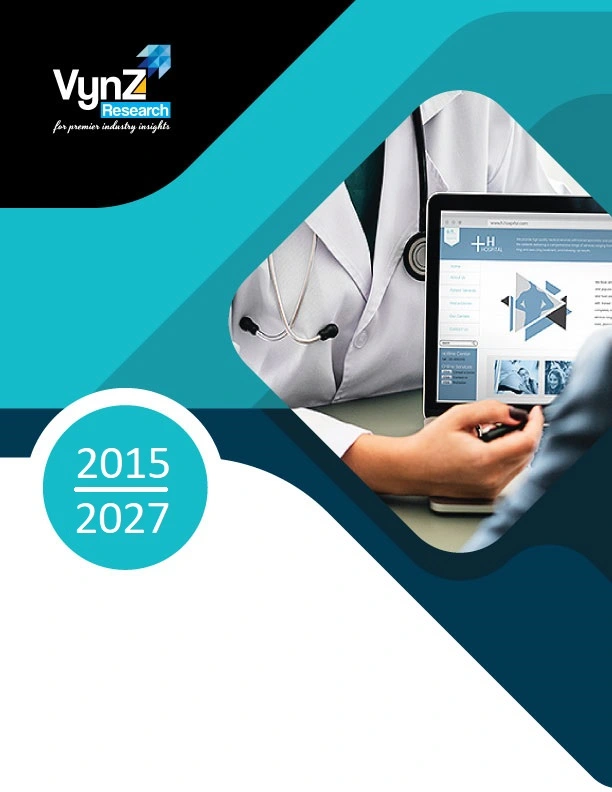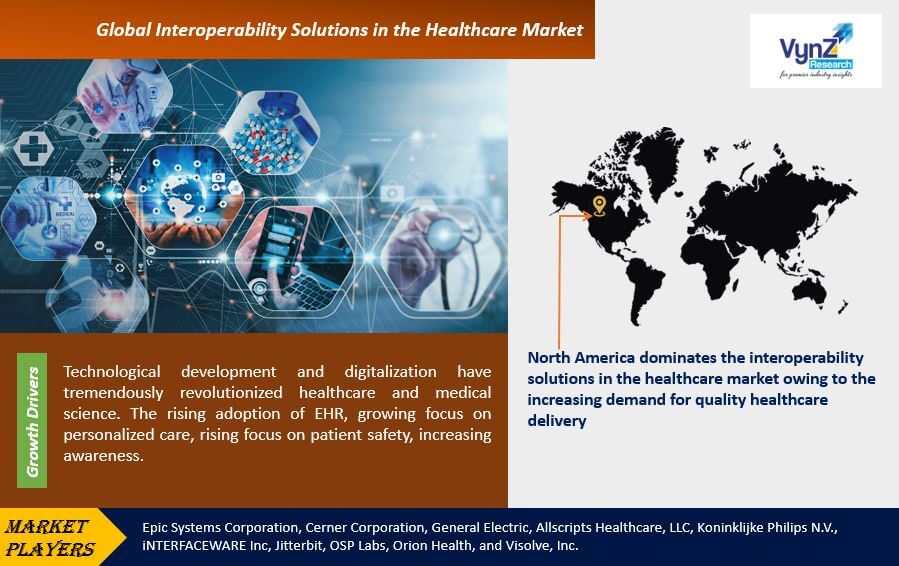| Status : Published | Published On : Dec, 2024 | Report Code : VRHC1238 | Industry : Healthcare | Available Format :

|
Page : 180 |

Global Interoperability Solutions in the Healthcare Market – Analysis and Forecast (2025-2030)
Industry Insight by Component (Software (EHR Interoperability Solutions, Laboratory Information Management System (LIMS) Interoperability Solutions, Imaging System Interoperability Solutions, Healthcare Information Exchange (HIE) Interoperability Solutions, Enterprise Interoperability Solutions, and Others) and Services), by Interoperability Level (Foundational Interoperability, Structural Interoperability, and Semantic Interoperability), by Deployment Model (Cloud-Based Model and On-Premise Model), by Application (Diagnosis, Treatment, and Others), by End-User (Patients, Providers(Hospitals & Clinics, Long-Term Care Centers, Diagnostic and Imaging Centers, and Others), Payers, and Pharmacies) and by Geography (North America, Europe, Asia-Pacific, Middle East, South America and Rest of the World)
Industry Overview
The Global Interoperability Solutions in the Healthcare Market were valued at USD 2.97 billion in 2023 and are expected to reach USD 6.15 billion in 2030, registering a CAGR of 5.9% over the projected period 2025-2030. The health Interoperability system contains several procedures, systems, and a populace that shares data and provides access to all the health information about individual data, accounts, and imagery. In the healthcare market, interoperability refers to the ability of different healthcare systems and applications to exchange, interpret, and use data in a seamless and meaningful way. Achieving interoperability is crucial for improving patient care, enhancing efficiency, and enabling innovation in healthcare.

The healthcare providers are taking video conferencing and telephone calls to monitor the status of the patients, resulting in the growth of the interoperability solutions market.
Interoperability Solution in the Healthcare Market Segmentation
Insight by Component
Based on component, the global interoperability solutions in the healthcare market is divided into software and services. Software is further sub-divided into EHR interoperability solutions, Laboratory Information Management System (LIMS) interoperability solutions, Imaging System interoperability solutions, Healthcare Information Exchange (HIE) interoperability solutions, enterprise interoperability solutions, and others. The service segment dominates the market in 2020 owing to the paradigm shift towards cloud computing which will decrease the operational cost and improves the performance of business processes and applications. Moreover, the recurring cost incurred on services like software updates and maintenance will also drive the growth of the service segment in the interoperability solutions in the healthcare market. Moreover, the HIE interoperability solutions segment is anticipated to have a high CAGR over the projected period owing to the need for accessing patient health information, and the rising adoption of healthcare IT solutions to increase the satisfaction of patients and their quality treatment.
Insight by Interoperability Level
Based on the interoperability level, the interoperability solutions in the healthcare market are categorized into foundational interoperability, structural interoperability, and semantic interoperability. Among these segments, structural interoperability dominates the market in 2020 owing to an increase in the adoption of technology like e-prescribing.
Insight by Deployment Model
On the basis of the deployment model, the interoperability solutions in the healthcare market are bifurcated into the cloud-based model and on-premise model. The cloud-based model is anticipated to drive the market owing to the rising demand for data exchange at a broader level and the benefits provided by these software platforms i.e., safe and efficient exchange of data at a lesser time.
Insight by Application
Based on application, the interoperability solutions in the healthcare market are segregated into diagnosis, treatment, and others. Among these segments, the diagnosis segment is anticipated to witness the largest share during the forecast period owing to the rising need for efficient information flow for the diagnosis of diseases. There is a need to have an accurate and timely diagnosis that will help healthcare professionals to monitor the patient’s condition.
Insight by End-User
Based on end-user, the interoperability solutions in the healthcare market are divided into patients, providers, payers, and pharmacies. Providers are further sub-divided into hospitals & clinics, long-term care centers, diagnostic and imaging centers, and others. Hospital’s segment dominates the market in 2020 owing to supportive government policies, an increasing number of patients, a rising need for data privacy, the implementation of several IT tools in healthcare settings like EHR, and error-free data management solutions.
Global Interoperability Solution in the Healthcare Market Report Coverage
|
Report Metric |
Details |
|
Historical Period |
2018 - 2023 |
|
Base Year Considered |
2024 |
|
Forecast Period |
2025 - 2030 |
|
Market Size in 2024 |
U.S.D. 2.97 Billion |
|
Revenue Forecast in 2030 |
U.S.D. 6.15 Billion |
|
Growth Rate |
5.9% |
|
Segments Covered in the Report |
By Component, By Interoperability Level, By Deployment Model, By Application and By End-User |
|
Report Scope |
Market Trends, Drivers, and Restraints; Revenue Estimation and Forecast; Segmentation Analysis; Impact of COVID-19; Companies’ Strategic Developments; Market Share Analysis of Key Players; Company Profiling |
|
Regions Covered in the Report |
North America, Europe, Asia-Pacific, Middle East, South America and Rest of the World |
Industry Dynamics
Industry Trends
The rising focus on healthcare interoperability solutions by medical authorities, increasing investments for enhancing healthcare facilities, rising funding by the government for healthcare interoperability, increasing emphasis on patient-centric care delivery are the trends prevalent in the interoperability solutions.
Health Information Exchange (HIE): HIEs are organizations that facilitate the exchange of health information among different healthcare providers, systems, and organizations. They establish standards and protocols for data sharing, allowing healthcare professionals to access and share patient data across different systems and settings.
Health Level Seven (HL7) Standards: HL7 is a set of international standards for the exchange, integration, sharing, and retrieval of electronic health information. HL7 standards define the structure, format, and content of health data, ensuring compatibility and interoperability between different healthcare applications and systems.
Fast Healthcare Interoperability Resources (FHIR): FHIR is a modern and flexible standard for healthcare data exchange, developed by HL7. FHIR uses web-based technologies and APIs (Application Programming Interfaces) to enable easy and standardized sharing of health information. FHIR allows for the exchange of discrete data elements, making it easier to integrate and aggregate data from different sources.
Application Programming Interfaces (APIs): APIs provide a standardized way for different software applications to communicate and interact with each other. In the healthcare market, APIs can be used to connect electronic health records (EHRs), medical devices, mobile apps, and other healthcare systems, enabling seamless data exchange and interoperability.
Interoperability Solution in the Healthcare Market Growth Drivers
Technological development and digitalization have tremendously revolutionized healthcare and medical science. The rising adoption of EHR, growing focus on personalized care, rising focus on patient safety, increasing awareness, and focus on healthcare interoperability solutions by healthcare authorities & hospitals are the factors that propel the growth of interoperability solutions in the healthcare market. Moreover, interoperability reduces the overall cost related to late diagnosis and treatment by providing real-time access to data.
Data Standardization: Standardizing health data formats, terminologies, and coding systems is essential for achieving interoperability. Commonly used standards include SNOMED CT (Systematized Nomenclature of Medicine--Clinical Terms), LOINC (Logical Observation Identifiers Names and Codes), and ICD (International Classification of Diseases). Data standardization ensures that healthcare information can be understood and interpreted consistently across different systems and organizations.
Data Governance and Privacy: Establishing robust data governance practices and ensuring patient privacy and security are critical for promoting interoperability. Compliance with regulations such as the Health Insurance Portability and Accountability Act (HIPAA) in the United States and the General Data Protection Regulation (GDPR) in the European Union is necessary to protect patient data and maintain trust.
Collaboration and Partnerships: Interoperability requires collaboration among healthcare providers, technology vendors, policymakers, and regulatory bodies. Stakeholders need to work together to develop and implement interoperability standards, share best practices, and address challenges and barriers to data exchange.
Interoperability Solution in the Healthcare Market Challenges
Lack of skilled IT professionals in the healthcare sector, rising complications due to inconsistent data and privacy concerns, monopolization of the EHR industry, lack of national patient identifiers, and lack of regulations are the challenges faced by the interoperability solutions in the healthcare market.
Interoperability Solution in the Healthcare Market Opportunities
The rising investment in emerging economies to enhance healthcare infrastructure, integration of blockchain technology, and medical device interoperability are opportunities in interoperability solutions in the healthcare market.
Recent Developments By the Key Players
Epic has introduced the AI Trust and Assurance Suite, which is designed to assist healthcare organizations in testing and monitoring artificial intelligence models. This suite aims to ensure the reliability and safety of AI applications within healthcare settings.
Royal Philips, a global leader in health technology, has expanded its cloud-based radiology informatics solutions to Europe, including exploring the use of generative AI to enhance radiology reporting.
Interoperability Solution in the Healthcare Market Geographic Overview
North America dominates the interoperability solutions in the healthcare market owing to the increasing demand for quality healthcare delivery, the need to control increasing healthcare expenditure, efficient EHR implementation by healthcare organizations, and initiatives and regulations to expand the efficiency of healthcare organizations in the region.
Interoperability Solution in the Healthcare Market Competitive Insight
The industry players are focusing on collaborations and partnerships, M&A, product launch, and creating geographical presence, and establishing brand value in the industry. The industry players are focusing on collaborations and partnerships, M&A, product launch, and creating geographical presence, and establishing brand value in the interoperability solutions in the healthcare market.
Some of the key players operating in the interoperability solutions in the healthcare market are:
- Epic Systems Corporation
- Cerner Corporation
- General Electric
- Allscripts Healthcare LLC
- Koninklijke Philips N.V.
- iNTERFACEWARE Inc
- Jitterbit
- OSP Labs
- Orion Health
- Visolve, Inc.
The Interoperability Solutions in the Healthcare Market report offers a comprehensive market segmentation analysis along with an estimation for the forecast period 2025–2030.
Segments Covered in the Report
- By Component
- Software
- EHR Interoperability Solutions
- Laboratory Information Management System (LIMS) Interoperability Solutions
- Imaging System Interoperability Solutions
- Healthcare Information Exchange (HIE) Interoperability Solutions
- Enterprise Interoperability Solutions
- Others
- Services
- Software
- By Interoperability Level
- Foundational Interoperability
- Structural Interoperability
- Semantic Interoperability
- By Deployment Model
- Cloud-Based Model
- On-Premise Model
- By Application
- Diagnosis
- Treatment
- Others
- By End-User
- Patients
- Providers
- Hospitals & Clinics
- Long-Term Care Centers
- Diagnostic and Imaging Centers
- Others
- Payers
- Pharmacies
Region Covered in the Report
- North America
- U.S.
- Canada
- Mexico
- Europe
- Germany
- U.K.
- France
- Italy
- Spain
- Russia
- Rest of Europe
- Asia-Pacific (APAC)
- China
- Japan
- India
- South Korea
- Rest of Asia-Pacific
- Rest of the World (RoW)
- Brazil
- Saudi Arabia
- South Africa
- U.A.E.
- Other Countries
.png)
Source: VynZ Research
.png)
Source: VynZ Research
Frequently Asked Questions
Purchase Options
Latest Report
Research Methodology
- Desk Research / Pilot Interviews
- Build Market Size Model
- Research and Analysis
- Final Deliverabvle
Connect With Our Sales Team
- Toll-Free: 1 888 253 3960
- Phone: +91 9960 288 381
- Email: enquiry@vynzresearch.com
Interoperability Solution in the Healthcare Market
